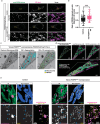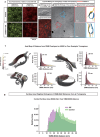Mitochondrial complexity is regulated at ER-mitochondria contact sites via PDZD8-FKBP8 tethering
- PMID: 40246839
- PMCID: PMC12006300
- DOI: 10.1038/s41467-025-58538-3
Mitochondrial complexity is regulated at ER-mitochondria contact sites via PDZD8-FKBP8 tethering
Abstract
Mitochondria-ER membrane contact sites (MERCS) represent a fundamental ultrastructural feature underlying unique biochemistry and physiology in eukaryotic cells. The ER protein PDZD8 is required for the formation of MERCS in many cell types, however, its tethering partner on the outer mitochondrial membrane (OMM) is currently unknown. Here we identify the OMM protein FKBP8 as the tethering partner of PDZD8 using a combination of unbiased proximity proteomics, CRISPR-Cas9 endogenous protein tagging, Cryo-electron tomography, and correlative light-electron microscopy. Single molecule tracking reveals highly dynamic diffusion properties of PDZD8 along the ER membrane with significant pauses and captures at MERCS. Overexpression of FKBP8 is sufficient to narrow the ER-OMM distance, whereas independent versus combined deletions of these two proteins demonstrate their interdependence for MERCS formation. Furthermore, PDZD8 enhances mitochondrial complexity in a FKBP8-dependent manner. Our results identify a novel ER-mitochondria tethering complex that regulates mitochondrial morphology in mammalian cells.
© 2025. The Author(s).
Conflict of interest statement
Competing interests: The authors declare no competing interests.
Figures








Update of
-
PDZD8-FKBP8 tethering complex at ER-mitochondria contact sites regulates mitochondrial complexity.bioRxiv [Preprint]. 2024 Jun 3:2023.08.22.554218. doi: 10.1101/2023.08.22.554218. bioRxiv. 2024. Update in: Nat Commun. 2025 Apr 17;16(1):3401. doi: 10.1038/s41467-025-58538-3. PMID: 38895210 Free PMC article. Updated. Preprint.
References
MeSH terms
Substances
Grants and funding
- R35 NS127232/NS/NINDS NIH HHS/United States
- JP19dm0207082/Japan Agency for Medical Research and Development (AMED)
- JP20H04898/MEXT | Japan Society for the Promotion of Science (JSPS)
- N/A/Secom Science and Technology Foundation (SSTF)
- JP22H05532/MEXT | Japan Society for the Promotion of Science (JSPS)
LinkOut - more resources
Full Text Sources
Medical

